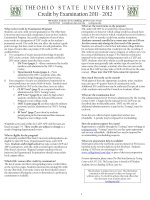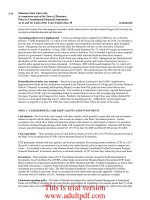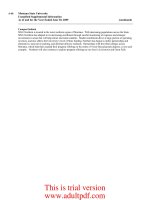adapting-the-oregon-state-university-cover-crop-calculator-for-idaho-conditions
Bạn đang xem bản rút gọn của tài liệu. Xem và tải ngay bản đầy đủ của tài liệu tại đây (349.66 KB, 9 trang )
ADAPTING THE OREGON STATE UNIVERSITY COVER CROP CALCULATOR
FOR IDAHO CONDITIONS
A. Moore1, C. Falen2, L. Hunter3, G. Shewmaker4, and D. Graybill1
1
University of Idaho, Twin Falls R&E Center, Twin Falls, Idaho
2
University of Idaho Extension, Lincoln County Extension, Shoshone, Idaho
3
University of Idaho Extension, Blaine County Extension, Hailey, Idaho
4
University of Idaho, Kimberly R&E Center, Kimberly, Idaho
INTRODUCTION
Many Idaho growers grow cover crops as a source of nitrogen for other crops in their
rotation. However, estimating the amount of nitrogen (N) released from a cover crop can be
challenging. Tools such as the Oregon State University (OSU) Cover Crop Calculator can predict
plant available nitrogen (N) from a recently tilled-under cover crop, based on the N
concentration in the tissue. The OSU calculator was developed with controlled incubation
studies, following N mineralization patterns for Oregon soils and plant tissue from plants grown
in Oregon. A major concern with using the OSU calculator for Idaho and other regions is
variations in soil type and in plant species between the two regions. The goals of this project
were to 1) adjust the OSU Cover Crop calculator to reflect Idaho conditions through N
mineralization incubation studies with Idaho soils and plants and 2) create and post a UI cover
crop calculator online for quick and easy access to Idaho growers.
CALIBRATION INCUBATION STUDY
The goal of the calibration incubation study was to evaluate ammonium and nitrate
concentrations over a 70 day period for a typical Idaho soil mixed with Idaho cover crops
containing various concentrations of N. This was the method used to develop the OSU cover
crop calculator, and is a standard method for evaluating mineralization of organic N from soil
amendments. We selected a Portneuf silt loam for the incubation study (mesic Durinodic Xeric
Haplocalcid), the most common agricultural soil in Southcentral Idaho. Plants included in the
incubation study were triticale, hairy vetch, Austrian pea, daikon radish, and red clover. We also
varied ratios of triticale and vetch or pea plant mixtures, to account for moderate tissue N
concentrations. Tissue N concentrations ranged from 1.3 to 4.4% N (Table 1).
7
Table 1. Tissue N concentrations for plants used in the Idaho cover crop calculator
calibration study.
Cover crop
Tissue %N
Triticale
1.3 – 1.7
25% Pea, 75% Triticale
25% Vetch, 75% Triticale
50% Pea, 50% Triticale
Red Clover
50% Vetch, 50% Triticale
Daikon Radish
2.3
2.4
2.9
3.0
3.1
3.3
75% Pea, 25% Triticale
75% Vetch, 25% Triticale
Austrian Pea
Wheat, early stage
Hairy Vetch
3.4
3.8
4.0
4.3
4.3 – 4.5
Plant tissue was collected from existing cover crop fields in Kimberly and Aberdeen,
Idaho. The plant tissue was clipped at soil level from four 1 ft. X 1 ft. square frames that were
placed randomly throughout existing cover crop fields. Plant tissue samples were analyzed for
tissue N concentration and dry matter content. Approximately 500 g of Portneuf silt loam (dry
basis) was mixed with 2 grams of chopped dry plant tissue and incubated for 70 days at 22⁰C in
plastic bags. Drinking straws were inserted in bags and bags were opened and massaged weekly
to insure optimum gas exchange for N mineralizing bacteria. Soil moisture was maintained at
80% field capacity. Bags were placed in an incubator in a randomized complete block design
with four replications. To reduce variability in moisture content between plant tissue samples, we
chose to use dried plant tissue instead of frozen tissue (frozen tissue was used for the OSU
incubation studies).
After 70 days of incubation, a quadratic model was fitted to the tissue N vs. Plant
Available Nitrogen (PAN) relationship, as was done in Vigil and Kissel (1991). The model fitted
to the data is: 𝑃𝐴𝑁% = −64.3 + 43.9 ∗ �𝑇𝑖𝑠𝑠𝑢𝑒 𝑁 %, r2 = 0.90 (Figure 1). For tissue N
concentrations ranging from 1.3 to 4.5%, our PAN results were much lower (-10 to 27% PAN)
than the OSU incubation study PAN results (10 to 60% PAN, comparison not shown?). A second
incubation was conducted to determine if PAN differences between the two studies were true
differences in soil and plant tissue origin, as opposed to a reflection of differences in the
experimental methodology.
8
60
Plant available N, mg kg-1
50
Hairy Vetch
40
30
20
10
0
Moist plant tissue
Triticale
Dry plant tissue
-10
-20
1
2
3
Tissue N %
4
5
-1
Figure 1. Comparing PAN (mg kg ) between dried and frozen fresh plant tissue from first
incubation study.
In the second incubation study, we compared a Canderly sandy loam from Oregon to a
Portneuf silt loam from Idaho, adding dried hairy vetch, dried triticale, and a 50/50 mixture of
dried vetch and triticale to both soils as the plant tissue source. We also compared dried plant
tissue collected from Idaho (vetch and triticale) to plant tissue collected in Oregon (plant species
unknown), applying the tissues to a Portneuf silt loam for comparison. Soil and plant tissue
origin effects did not have a statistically significant effect on PAN after 70 days of incubation
(data not shown).
In addition to soil and plant origin effects, we also wanted to see how much the plantdrying was affecting PAN. To address this question, fresh and dried samples of hairy vetch and
triticale were added to a Portneuf silt loam at a rate of 2 g of plant tissue (on a dry basis) to 500 g
of soil. Water additions were adjusted for plant moisture contents to insure that each bag had the
same moisture content. Tissue moisture had a significant effect on PAN after 70 days of
incubation. Fresh tissue samples released approximately 15.7 ppm more PAN than dried tissue
samples, regardless of tissue N concentration (Figure 2). As a result of this finding, we added
15.7 ppm to PAN values from the dried plant tissue calibration study PAN values to more
accurately predict PAN from living moist plant tissue. We used this adjusted model for
prediction of PAN from fresh tissue (aka green manures) and used our original Idaho calibration
for prediction of PAN from dried tissue (aka crop residues) both models are shown in Figure 2.
9
Figure 2. Equations and calibration data supporting the University of Idaho Cover Crop
Calculator, which estimates PAN in the soil over 70 days of incubation for fresh and dried
cover crop residues on an irrigated Portneuf soil in Southern Idaho. Green manure data
points were extrapolated from dry residue data points, increasing PAN by 15.7 ppm.
10
INTERFACE FOR THE UNIVERSITY OF IDAHO COVER CROP CALCULATOR
Our goal was to create a simple and efficient interface for the calculator, as online
calculators can often overwhelm users with too many inputs, outputs, and extraneous information
(Figure 3). Additional pages include: Calculator User’s Guide, Plant Tissue Sampling Guide, and
Calculator Development Information. An additional calculator designed with altered units for
small acreage farms and gardens is also included on the website.
Figure 3. Online interface for the University of Idaho Cover Crop Calculator. The website
and supporting materials are located at
/>Online calculator and website were developed by University of Idaho graduate student,
David Graybill.
11
COMPARISON TO OREGON COVER CROP CALCULATOR
In Figure 4, we compared the University of Idaho Cover Crop Calculator equations to
theVigil and Kissel (VK) equation used to support the OSU cover crop calculator and the
calibration equation used to justify use of the VK equation for the OSU cover crop calculator.
The goal of this comparison is to help us understand how and maybe even why the Idaho tissue
N-PAN equations differ from the Oregon tissue N-PAN equations.
The Idaho calculator predicted less PAN than the Oregon calculator at tissue N above
2.0%. This difference may be due to the alkaline nature of Idaho soils, which could limit N
mineralization activity in the soil. While the comparison between Oregon and Idaho soil did not
show a significant effect on PAN, more soils were needed in this comparison to adequately state
that there is not a soil effect between the two regions.
The VK and UI dry tissue models predicted immobilization below 1 and 2% tissue N,
respectively, while the fresh and frozen tissue models do not predict immobilization at any tissue
N concentration. This finding reiterates the importance of not relying on incubation studies using
dried plant tissue for prediction of PAN from fresh tissue.
70
Predicted Plant available N %
60
50
40
30
20
10
Frozen tissue, OSU calibration
0
Dry tissue, Vigil and Kissel, 1991
-10
Fresh tissue, UI calibration
-20
Dry tissue, UI calibration
-30
0.5
1.5
2.5
3.5
4.5
5.5
Tissue N %
Figure 4. Comparing the University of Idaho Cover Crop Calculator equations (green and
brown lines) to VK equation used to support Oregon State University cover crop calculator
(blue line) and the calibration equation used to justify use of the VK equation for the OSU
cover crop calculator (purple line).
12
VALIDATION INCUBATION STUDY
We conducted an incubation of cover crop tissue and soil samples collected from four
grower fields in South-Central and South-Western Idaho to determine if the cover crop model
would be applicable to Idaho soils and plant tissue beyond what was used in the calibration
study. Soils and plant tissue were sampled within a few days prior to plow-down. Because
grower plant tissue was dried, we used the cooperator validation incubation study to validate the
crop residue equation instead of the green manure equation. Information on soil characteristics
and plant available nitrogen (predicted and observed) are listed in Table 2. Observed and
predicted PAN were similar but have not been evaluated statistically.. This finding suggests that
PAN was minimally influenced by soil type among four Southern Idaho agricultural soils,
illustrating that the UI cover crop calculator would be appropriate to use for most Southern Idaho
soil types.
Table 2. Soil characteristics, observed PAN from incubation, and predicted PAN from UI
cover crop calculator (crop residue equation), using soils and dried plant tissue from four
cooperator fields in Southern Idaho.
Grower
field ID
Region
Grower
1
Grower
2
Grower
3
Grower
4
Southwestern
Idaho
South-central
Idaho
South-central
Idaho
Southwestern
Idaho
Soil
pH
Green
Manure
Crop
%
Tissue
N
Observed
PAN,
dried
tissue
(%)
Predicted
PAN,
dried
tissue
(%)
20.0
7.7
Pea/Wheat/
Vetch
3.8
16.9
21.8
7.9
5.2
7.5
Wheat
1.7
-5.7
-6.4
2.4
4.5
6.2
7.7
Pea/Wheat
2.8
15.5
9.1
1.9
16.2
5.4
7.0
Rye
2.9
11.0
9.9
%
Clay
Initial
soil
nitrate
(ppm)
2.2
6.2
1.7
%
Soil
OM
13
To estimate PAN for each of our growers’ fields, we inserted the grower information for
biomass into the green manure version of the UI cover crop calculator. The total N release
ranged from 7 to 36 lb N/acre (table 3). In addition to tissue N, it is important to note that the
biomass amounts also greatly influence the Calculators predicted total N released from green
manures. For example, the rye field was estimated to release over twice as much N as the
pea/wheat field despite having similar tissue N concentrations, due to differences in biomass.
Therefore, conditions allowing for high biomass production (longer growing season, timing of
planting, species selection and mixture, etc.) in addition to selecting high N plants (vetches, peas,
etc.) will allow for Idaho growers to gain significant amount of N from cover crops.
Table 3. UI Calculator predicted quantity of total N release and the PAN from cooperator
green manure crops, based on tissue N concentration and biomass inputs.
Cooperator Green
Manure Crop
Tissue N (%)
Biomass (dry
ton/acre)
Predicted Total
N release (lb
N/acre)
Predicted PAN
(lb N/acre)
Pea/Wheat/Vetch
3.8
1.4
113
36
Wheat
1.7
1.1
39
7
Pea/Wheat
2.8
0.7
41
11
Rye
2.9
1.8
103
27
DISCUSSION
The new University of Idaho Cover Crop Calculator developed from this project will
allow for Idaho growers to account for N from their cover crop, which will help to prevent overand under-application of N fertilizers. Also, Idaho growers who have been using the Oregon
calculator will now be able to more accurately predict N coming from their crops than they have
in the past. Other benefits of the calculator include simplicity (only four inputs), easy to access
from the internet, and does not require any experience with modeling to use. Finally, this will
provide a calculator specific to Idaho conditions.
As with any model, there are limitations as to what the UI Cover Crop Calculator is able
to do. For example, simple models like this one that require minimal inputs cannot account for
the wide variety of variables that impact nitrogen mineralization. While N concentration appears
to be the driving factor in N mineralization rates, fluctuations in soil temperature and soil
moisture content can also have an impact. Also, the Idaho Cover Crop Calculator is only
designed to be used for spring-incorporated irrigated cover crops in Southern Idaho. Users from
other regions should use the calculator with caution.
Collecting and analyzing plant tissue is a key part of this calculator. Growers who are
unable to do this step may guess at these values, which will greatly increase the chance for
erroneous results. Also, the calculator provides a single value of predicted N over the entire
season instead of N release patterns throughout the growing season, which may be frustrating to
growers who want to time in-season fertilizer applications with N release patterns.
While we have learned a lot from this project, we still have a lot of questions about
estimating N mineralization from cover crops. For example, with more growers showing interest
in no-till systems, we would like to understand more about the release of N from crop residues
14
that are not incorporated into the soil. We would also like to understand more about the N
mineralization patterns of fresh tissue instead of dried tissue. Finally, information on the timing
of nitrogen release over the growing season would help growers time fertilizer applications with
expected N release events from planted cover crops.
REFERENCES
Vigil, M.F. and D.E. Kissel. 1991. Equations for estimating the amount of nitrogen mineralized
from crop residues. Soil Sci Soc Am J. 55:757-761.
Andrews, N., D. Sullivan, J. Julian, and K. Pool. Organic fertilizer and cover crop calculator.
Accessed October 2013.
Sullivan, D.M. and N.D. Andrews. 2012. Estimating plant-available nitrogen from cover crops.
PNW 636. p. 23. Oregon State University Extension.
Sullivan, D.M., R. Datta, N. Andrews, and K. Pool. 2011. Predicting plant-available nitrogen
release from cover crop residues. Proceedings of the Western Nutrient Management
Conference. Vol. 9. March 3-4, 2011. Reno, Nevada. p. 55-60.
15









